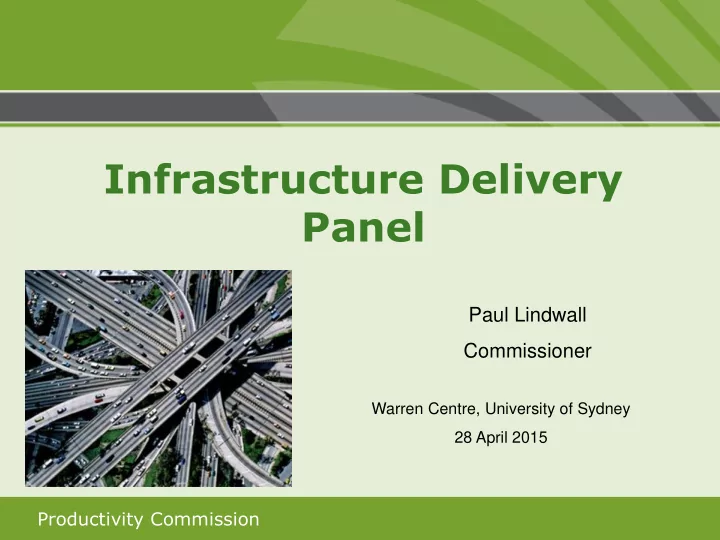

Infrastructure Delivery Panel Paul Lindwall Commissioner Warren Centre, University of Sydney 28 April 2015 Productivity Commission
Growth in living standards 1986-87 to 2012-13, per cent 6 3 0 -3 Real GDP per capita Real net national disposable income per capita -6 1986- 1988- 1990- 1992- 1994- 1996- 1998- 2000- 2002- 2004- 2006- 2008- 2010- 2012- 87 89 91 93 95 97 99 01 03 05 07 09 11 13 Source: ABS (Australian System of National Accounts, Cat. no. 5204 , Nov 2013). Productivity Commission 2
Contributions to growth in average incomes – forecast labour productivity growth Percentage points contribution, annual average 4 4 Forecast labour productivity growth (Treasury) 3 3 2 2 1 1 0 0 -1 -1 1960s 1970s 1980s 1990s 2000s to 2013 Decade to 2023 Labour productivity Labour utilisation Terms of trade Net foreign income Per capita income Source: PC estimates based on ABS, Australian System of National Accounts , 2012-13 , Cat. no. 5204.0, Table 1 & Treasury calculations. Productivity Commission 3
Contributions to growth in average incomes – needed for long run GNI growth Percentage points contribution, annual average 4 4 Productivity growth needed to preserve long-run GNI per capita growth 3 3 2 2 1 1 0 0 -1 -1 1960s 1970s 1980s 1990s 2000s to 2013 Decade to 2023 Labour productivity Labour utilisation Terms of trade Net foreign income Per capita income Source: PC estimates based on ABS, Australian System of National Accounts , 2012-13 , Cat. no. 5204.0, Table 1 & Treasury calculations. Productivity Commission 4
Key productivity trends 60 Cumulative growth Labour productivity since 1993-94, per cent Recent rise in LP only part of the story 30 Multifactor productivity Capital productivity 0 Continued decline Capital productivity is the major drag on Australia's (measured) productivity performance -30 1993-94 1995-96 1997-98 1999-00 2001-02 2003-04 2005-06 2007-08 2009-10 2011-12 Sources: ABS (Estimates of Industry Multifactor Productivity, Cat. no. 5260.0.55.002, Dec 2013). Productivity Commission 5
Rome’s Cloaca maxima and Madrid’s Ciudad Real airport Still in use after Closed after 2600 years four years Productivity Commission 6
An Ancient PPP contract Dr Robert Pitt, Deputy Director British School at Athens Temple of Zeus Basileus in Lebadeia Productivity Commission 7
Expenditure on engineering construction work for the public sector (per cent of GDP) Productivity Commission 8
Canal, rail, road Par UK Productivity Commission 9
Autonomous car Productivity Commission 10
Project selection Productivity Commission 11
Understanding construction costs Bidding price, quality & timeliness v Intermediate inputs Market structure (cement, bitumen, steel) Costs v Cost of debt Factors largely v Economywide labour costs outside policy v Land costs control Productivity v Tunnelling v Scale economies v Firm innovation Procurement Industrial Regulations capabilities & Labour skills relations models Productivity Commission 12
Funding • Well-designed user charges should be used to the fullest extend that they can be economically justified • There is a political economy problem in some jurisdictions with cost based user charges, especially roads, but increasingly energy • However, because of an absence of well- functioning product markets, significant externalities or distributional issues, some infrastructure can only be government-funded Productivity Commission 13
Financing No shortage of private finance if the price is right • Public sector financing constraints largely self-imposed • if right projects are selected and properly funded Guarantees, concessional loans and tax concessions • are costly, lack transparency and potentially distortionary Only if implemented well does private sector • involvement (including financing) deliver efficiency gains − Private sector financing does not offset all fiscal pressures Productivity Commission 14
Conclusion Transparent cost-benefit analysis for project selection • Better data collection • Apply user charges • Allocate risk appropriately • Build in flexibility • Credibly reserve corridors but allow alternative use • Better procurement practices • More efficient approval processes • Displacing bad projects with good ones • Managing procurement and financing/funding better • Privatise assets more efficiently managed by private sector • Productivity Commission 15
Thank You www.pc.gov.au Productivity Commission 16
Recommend
More recommend